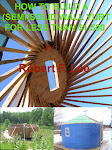As another winter passes, an examination of our yurt skin
reveals numerous puncture holes. A few are courtesy of squirrels, who love to
scurry across the dome. Some are stress
tears – a result of four years of wind, hail, ice, snow and old age. Many are from branches that have broken from
nearby trees and been impelled into the tarpaulin skin. Regardless, each provides a source of
leakage, and requires repair.
There are a number of options for repairing these breaks in
the waterproof and wind resistant shell.
Most commonly recommended is the use of tarpaulin tape. However, I find this to be the least
effective, as, unless the surface is cleaned immaculately and the tape seals in
the hot sun before the cool nights or moisture curl the edges, the tape lasts
less than a full season.
I have used two more conventional solutions, and been
satisfied with both. The first is a
simple vinyl repair kit, the type used to repair pool liners, kids’ air
mattresses or even bicycle tire tubes.
Bicycle repair kits commonly are rubber-based and less effective that
vinyl or pvc compounds. The second is kitchen
and bathroom silicone sealant. By applying
a thick layer under the tarp hole, and then a second thin skin after the first
dries, you obtain a good waterproof seal that is also flexible.
The most environmentally friendly solution though, is also
the simplest and least expensive: birch or poplar tree resin! By cutting into the tree in the spring, you
can obtain a good, thick resin that will harden throughout the summer. When ready for use, simply heat the resin in
a small sealed container in boiling water, then apply it in layers as it cools
and hardens on the hole. Zero cost, zero impact on the environment! It isd a solution appropriate for the
eco-friendly yurt.



